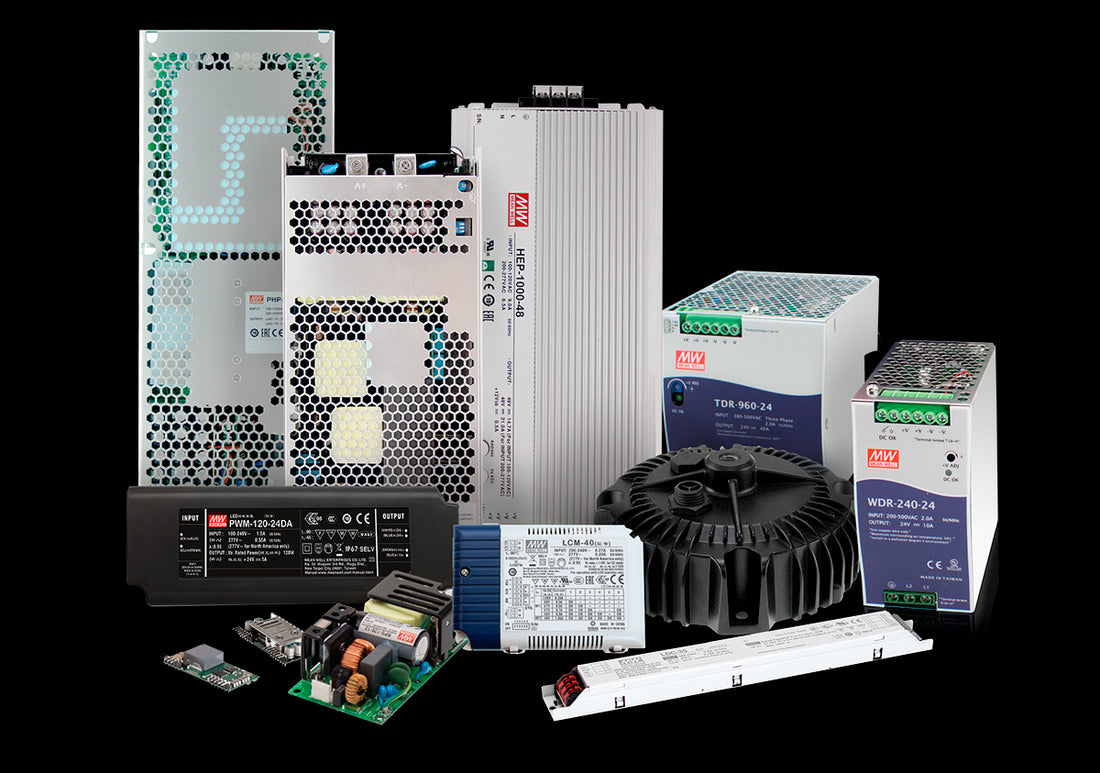
An In-Depth Guide to 12V, 24V, and 48V Switching Power Supplies
Share
Introduction
Switching power supplies (also known as switch-mode power supplies or SMPS) are essential components in modern electronics, providing efficient power conversion with low heat generation. They are popular across industries, used in everything from LED lighting and industrial equipment to telecommunication systems. Among the most common voltage outputs are 12V, 24V, and 48V, each serving unique applications and industries. In this article, we’ll explore the differences, advantages, and applications of 12V, 24V, and 48V switching power supplies, while highlighting key considerations for choosing the best SMPS for your needs.
What Is a Switching Power Supply?

A switching power supply (SMPS) converts electrical power efficiently by switching electronic components on and off at high frequencies, enabling the conversion from AC to DC while minimizing energy loss. Unlike traditional linear power supplies, which use large transformers, switching power supplies are compact, efficient, and suitable for high-powered applications.
Key Features of Switching Power Supplies
1. High Efficiency: With conversion rates often exceeding 80%, SMPS is ideal for applications where energy efficiency is crucial.
2. Compact Size: Switching power supplies are generally smaller and lighter than linear power supplies, making them suitable for limited spaces.
3. Thermal Management: Lower heat generation and built-in cooling mechanisms help switching power supplies operate effectively.
4. Voltage Regulation: SMPS offers precise voltage control and can maintain output stability under fluctuating input loads.
Common Voltages: 12V, 24V, and 48V Switching Power Supplies
12V, 24V, and 48V are among the most common output voltages for SMPS due to their compatibility with various devices and systems.
12V Switching Power Supplies
A 12V switching power supply is widely used in low-power applications, making it ideal for:
• LED Lighting: 12V SMPS is perfect for powering LED strips, outdoor lighting, and automotive lighting systems.
• Consumer Electronics: Many household devices, such as routers, modems, and small appliances, run on 12V power supplies.
• Portable Chargers: Portable chargers and battery packs often use 12V outputs for recharging.
• Security Systems: CCTV cameras and access control systems often require a reliable 12V power source.
Benefits of 12V Power Supplies:
• Compatible with many household and automotive electronics.
• Offers efficient, low-power solutions with minimal heat generation.
24V Switching Power Supplies
24V power supplies are more robust, often used in mid-power applications. Common applications include:
• Industrial Automation: PLC controllers, HMI panels, and relays typically operate on 24V power supplies.
• Machinery and Equipment: Many industrial tools, such as CNC machines and automated systems, are designed to work with 24V.
• Telecommunications: Networking and communication equipment often utilize 24V power supplies due to their reliability.
• Commercial LED Lighting: Many commercial LED systems, especially in larger installations, prefer the stability of 24V supplies.
Benefits of 24V Power Supplies:
• Suitable for both industrial and commercial applications.
• Provides enhanced stability and efficiency for mid-power requirements.
48V Switching Power Supplies
48V power supplies are ideal for high-power applications, commonly used in industries such as:
• Telecommunications: 48V DC power is the standard for telecom systems, providing reliable power to base stations, routers, and switches.
• Data Centers: Data centers and servers often rely on 48V power supplies for efficient power management.
• Electric Vehicles (EVs): Some electric vehicles and charging stations operate on 48V systems to drive heavy equipment and systems.
• Renewable Energy Systems: Solar inverters, wind turbines, and battery storage systems often use 48V to manage high-capacity energy requirements.
Benefits of 48V Power Supplies:
• High power output suited for industrial-grade applications.
• Increased efficiency and reduced current draw, minimizing power loss over long distances.
Key Considerations When Choosing a Switching Power Supply
1. Voltage Output: Ensure compatibility with your devices’ voltage requirements to avoid damage or inefficiency.
2. Current Rating: Select a power supply with a current rating that matches or slightly exceeds the needs of your device.
3. Temperature Range: Choose a power supply rated for the temperature range of your operating environment to ensure stable performance.
4. Efficiency: Higher efficiency ratings are crucial, especially for devices that will be powered for extended periods.
5. Safety and Certifications: Look for certifications like CE, UL, and RoHS, which ensure quality, safety, and compliance with international standards.
Advantages of Switching Power Supplies Over Linear Power Supplies
Switching power supplies are widely favored due to:
• Higher Efficiency: Up to 90% efficiency in some designs, which reduces electricity consumption.
• Compact and Lightweight Design: Lower component requirements allow for a smaller form factor.
• Reduced Heat Generation: Less power is wasted as heat, which minimizes cooling requirements.
• Versatile Applications: With a wide range of voltages available, SMPS can support many different devices and industries.
Applications of 12V, 24V, and 48V Power Supplies
Switching power supplies find applications across various sectors:
• Consumer Electronics: Compact devices, such as mobile chargers, use 12V power supplies for portability and convenience.
• Industrial Equipment: 24V power supplies run industrial automation, machinery, and robotics for stable and efficient power.
• Telecommunications: 48V power supplies maintain uptime and efficiency for communication and data systems.
• Electric Vehicles: Both 24V and 48V systems are used for powering auxiliary equipment and battery charging stations in electric vehicles.
Conclusion
Switching power supplies are essential components that power a vast range of applications with remarkable efficiency and reliability. Whether you need a 12V power supply for a small electronics project, a 24V power supply for industrial automation, or a robust 48V power supply for telecommunications, choosing the right SMPS can ensure optimal performance, energy savings, and system longevity. For any business or industry operating in today’s energy-conscious world, switching power supplies offer the ideal solution to power devices and infrastructure efficiently and sustainably.
